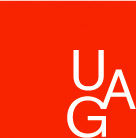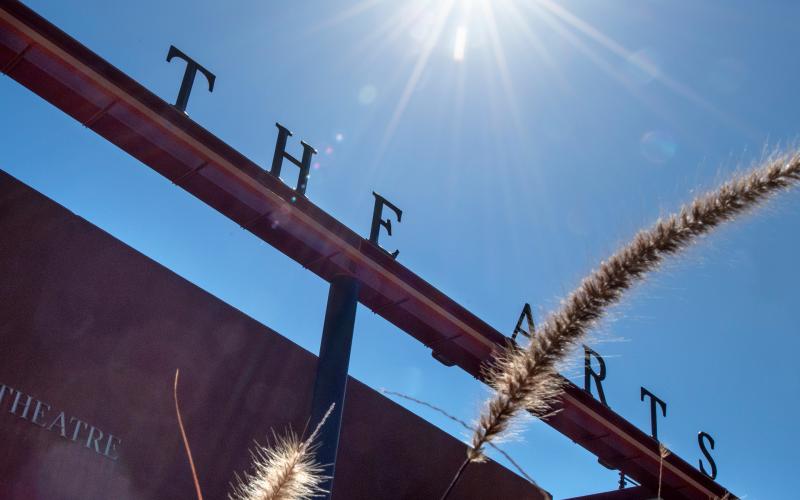Emerging Brighter
UCI student artists discovered and honed new skills in 2021
By Christine Byrd
When UCI moved operations online a year and a half ago, everyone gained new skills: creating an at-home studio, mastering Zoom meetings and troubleshooting technology. But as artists struggled to keep their creative spark alive through the pandemic, many found themselves forced to incorporate technology into their work in new and exciting ways.
While Claire Trevor School of the Arts students, faculty and staff welcome the return to live performances and exhibitions, they come to this new stage wielding skills that make them more resilient, marketable and, yes, even more creative.
Acting Alone
In this fall’s production of Human Error, transfer student in drama Chris Hathaway plays Heather, a wife and mother who undergoes in-vitro fertilization and accidentally ends up pregnant with another couple’s baby. The biological parents are at the opposite end of the political spectrum from Heather and her husband.
Although the script is laugh-out-loud funny, Hathaway performed to empty seats and silence in the Robert Cohen Theatre over the course of nine weeks in the spring. She stood in front of a green screen with a lone camera recording her performance. Off to the side, her cell phone allowed her to see other cast members who were similarly sequestered in their own individual studio spaces across the school.
“I’m so eager to have people see Human Error, and I hope it looks like it was easy to do,” says Jane Page, professor of drama and director of the play.
There are times in life when you’re going to have to act alone...
In fact, nothing about it was easy, from the set-up of actors in individual spaces, to the fact that Broadway cinematographer Mark Ciglar spent two months editing the actors together into scenes and replacing the green screen with relevant backdrops.
Page reminded the performers again and again that they were cast because of their talent as actors, not technical experts, even though the experience amounted to a crash course in film technology. Still, the skills they gained will serve useful in their stage acting careers, such as with remote casting calls.
“There are times in life when you’re going to have to act alone, without the benefit of other people in the scene, and I’ve always struggled with that,” says Hathaway. “It was hard, but it’s something I’m really grateful I got to practice with Human Error. In the end, what a gift this experience was.”
Documenting Art
The shift to online work forced art students to focus more on documenting their work through photos, videos, websites, social media and brochures. Already a standard practice in art, documentation became even more critical when in-person exhibitions were nearly impossible.
“The students demonstrated such an incredible level of resilience in the face of uncertainty. It was really inspirational working with them,” says Liz Glynn, associate professor of art. “We’re all looking forward to being in person again, but every student now has an expanded toolbox from which to work.”
Glynn led the undergraduate honors exhibition course, helping the students brainstorm ways to safely stage an exhibition in compliance with all campus safety protocols. They decided to use projectors to beam their final projects onto the walls of CTSA buildings, in an installation they called Mimosas After the Funeral. For two nights in May, the students projected their work on the walls and walkways, and they were able to stroll through and enjoy each other’s creativity.
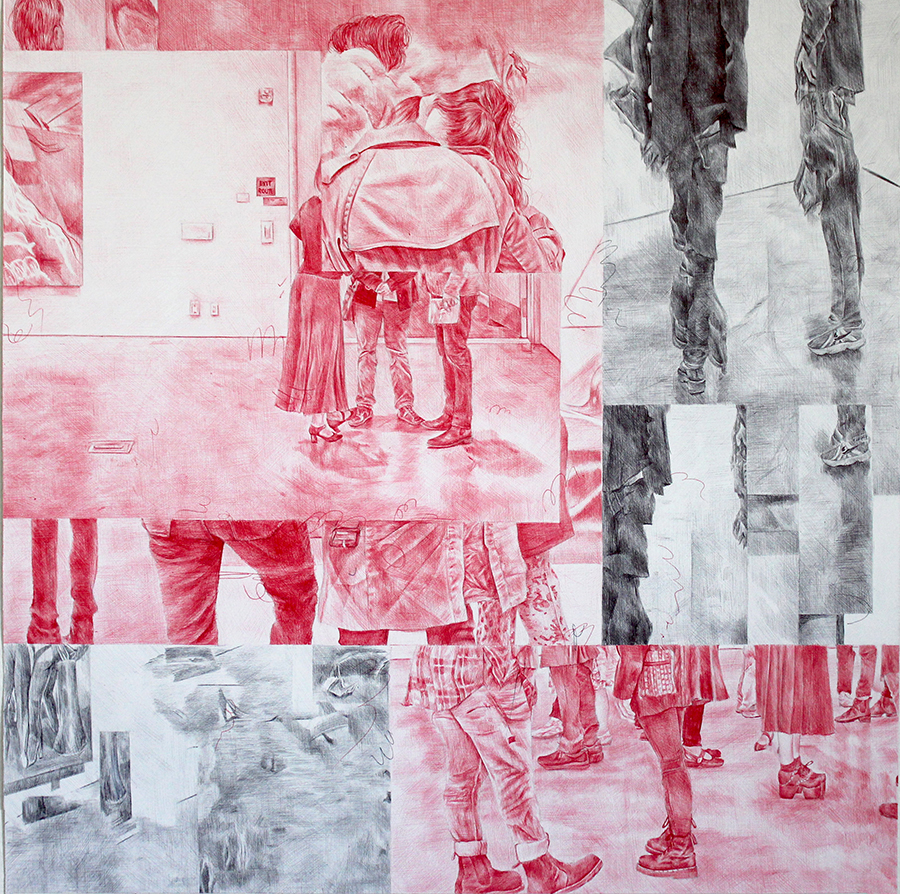 “This one incredible week was the highlight of my senior year,” says Audrey Hernandez Peterson, ’21, who majored in art and sociology. “It was magical to be around other artists and students when you haven’t had that experience in so long.”
“This one incredible week was the highlight of my senior year,” says Audrey Hernandez Peterson, ’21, who majored in art and sociology. “It was magical to be around other artists and students when you haven’t had that experience in so long.”
Having previously interned at the University Art Gallery, Peterson used older photos of people inside the gallery enjoying exhibitions to create drawings and collages that she then projected onto the exterior of the gallery — a place where she made so many memories as a student. After the installation, she helped make a printed brochure showcasing her classmates’ projects, a lasting reminder of their “ephemeral exhibition.”
Peterson was also president of Catalyst, the undergraduate student art gallery, which went virtual during the pandemic. Instead of a series of individual artists’ shows, she and the other members developed a website, an Instagram page and two online volumes showcasing undergraduate artwork, called Time Delayed.
“We all surprised ourselves with how much we were able to produce and how proud we all were of it,” says Peterson. “Emerging brighter means respecting the past and all the low points we went through, but knowing that things do actually get better.”
“Emerging brighter means respecting the past and all the low points we went through, but knowing that things do actually get better.”
Image: For her senior art exhibit, Audrey Hernandez Peterson, ’21, created a collage from photos taken when she interned at the University Art Gallery in 2019. Saturday, January 11th, 2020, 2-5 pm, 22 x 30 inches, graphite on paper, 2021.
Networked Music
CTSA benefits from being home to one of the leaders in networked music, a method of using the internet to allow musicians in different geographic locations to perform together. Professor of Music Michael Dessen has been active in the field, also called telematic music, since 2007 and participated in dozens of networked concerts.
More UCI students have been exposed to the process out of necessity now. Matthew Nelson, a fourth-year music major, took a graduate-level networked music class last fall, where he learned how to run popular software JackTrip. He also became keenly aware of the challenges to playing music online: split-second delays, bandwidth, and sound quality.
By the spring, Nelson was the music department’s technical assistant and, working from his on-campus apartment, he managed rehearsals for live performances featuring student musicians playing together from various locations.
Pre-show jitters for a networked performance are entirely different from an in-person concert, he says.
“I’m used to relying on my practice and knowing the music to do the gig. But with this, you know that things beyond your control can fail — like the campus network,” Nelson says. For their networked music performances, Nelson and the team prerecorded backup videos, just in case the live feed encountered a show-stopping problem.
“I’ve grown interested in the computer science aspect of networked music,” Nelson says. “I’m a traditional jazz player, but I’ve grown to like implementing technology into my playing.”
In addition to using JackTrip, Nelson has experimented with other software, as well as other musical forms that lend themselves to remote collaboration. For example, Nelson has jammed with musicians in Japan, playing music that’s not driven by a beat, but more “textural and ambient” so that the time delay of the sound traveling across the ocean doesn’t matter.
“Some of our students got interested in the possibilities of networked performance and remote collaboration, and will continue to explore that in their creative work,” says Dessen. “But even for those who won’t, general skills such as collaborating remotely, and improving communication skills are incredibly useful.”
Dessen points out that for many students, the pandemic provided their first experience using audio equipment like microphones and audio interfaces, as well as performing with a personal headphone mix, which is common in recording studios.
“I think the past year has increased our collective skill with remote collaboration and even more importantly, it has opened up people’s imaginations to more possibilities for using networks not to substitute for what we do in person, but to extend on it in powerful ways,” Dessen says.
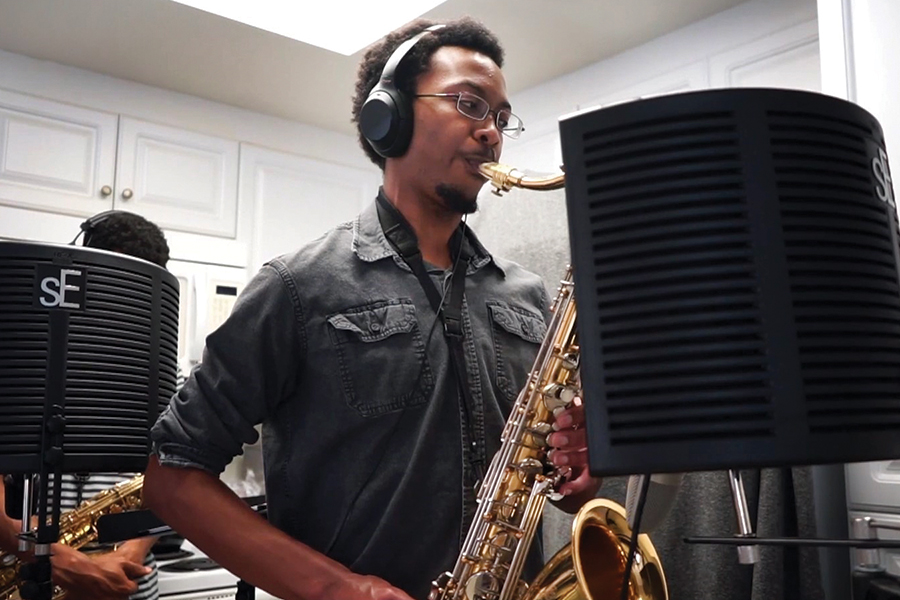
Image: A screenshot of Matthew Nelson performing tenor sax as part of the 2021 CTSA Commencement virtual celebration.
Filming Dance
Screendance is another art form that’s been embraced by the CTSA during the pandemic. Here again, the school benefits from faculty who have years of experience blending technology and film with dance. While courses about Dance on Film and Screendance were already part of CTSA’s dance curriculum, they gained traction over the past year.
“Of course you can film dance, but how do you make dance into film? Screendance is a hybrid genre combining cinematography and choreography,” says Chad Michael Hall, associate professor of dance.
“The pandemic forced us all to put dance in front of the camera in order to show our work, whether we were calling it screendance or not.”
Within weeks of the campus shutting down, a scheduled undergraduate dance showcase, Physical Graffiti, was transitioned to an online show. But in the interceding months, students and faculty thought even more seriously about how to convey their dance via video.
This opened up entirely new perspectives for both dancers and choreographers.
“The screen is the destination, the venue,” says Hall. “The audience is your entire world.”
Hall spearheaded a screendance initiative for the American College Dance Association, including a series of workshops to train choreographers and dancers on the basic principles of the form, as well as a juried competition.
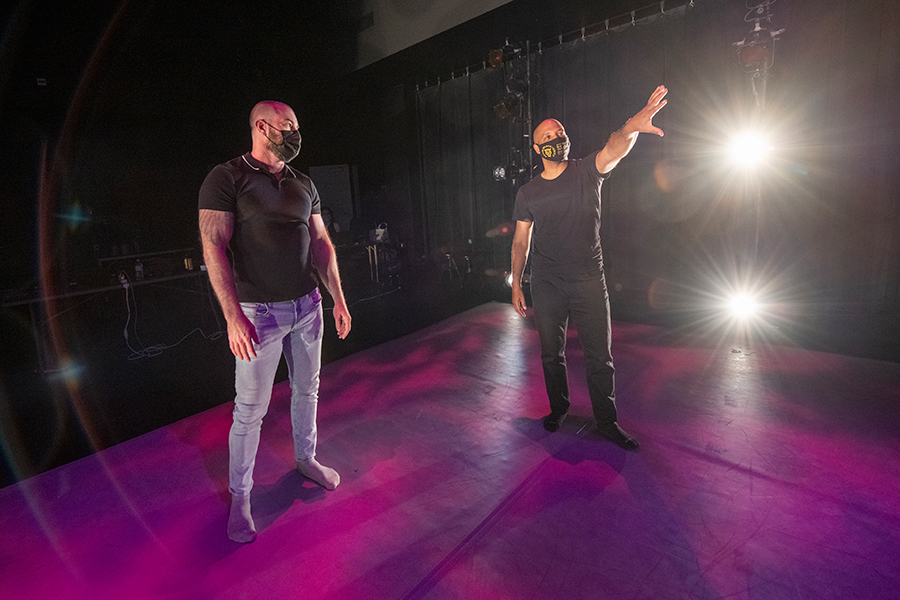
Image: Professor Chad Michael Hall (left) mentors Marc Spaulding (M.F.A. ‘21) for his final thesis project, a screendance, which was filmed in the Experimental Media Performance Lab (xMPL) on campus. Photo: Steve Zylius
M.F.A. student Kelly McGill says that with screendance, she’s learned to think about different ways to show movement beyond an entire body seen on a stage. With video, she can do close-ups of a hand or a face, show movements from overhead or behind, or even have the dancer move around the camera.
Early in the pandemic, McGill says she was experimenting with the camera angles and with editing software, but through Hall’s screendance course, she learned to be more intentional and purposeful in her choreography and filming. Over the summer, she received a
Medici Circle scholarship to fund a screendance that she hopes to submit to juried festivals all around the world.
As we’re coming out of this situation where our lives have been lacking so much energy and joy, and we’re coming back trying to celebrate all the joy and energy that life has.
Set to music composed by a UCI student, three dancers in a completely white studio will move as colorful confetti begins to drift around them, with fans kicking the colors into the air, and the dancers’ movements creating patterns in the confetti on the floor. McGill drew inspiration through her experience in the pandemic.
“We started in a very blank and isolated place, but we’re eventually coming to this place where there’s so much more light and color and vitality,” explains McGill. “As we’re coming out of this situation where our lives have been lacking so much energy and joy, and we’re coming back trying to celebrate all the joy and energy that life has.”
The dancers, like the rest of CTSA’s artists, are emerging brighter.
View the upcoming online production of Human Error (tickets available).
Learn more about various events and research happening in the school on our website at www.arts.uci.edu.
Please visit our secure direct giving page and make a gift to support to CTSA today!
